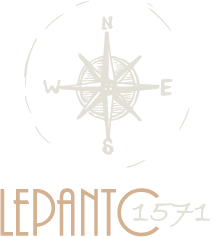Historical overview: the port and its strategic and commercial importance
The foundation of the city and the port of Naupaktos is intrinsically linked to its strategic position, since it is situated on a communication “hot-spot” between the Peloponnese and Mainland Greece, controlling the western entrance to the Corinthian Gulf. In antiquity Naupaktos as a naval base played an important role particularly during the Messenian wars and, later on, the Peloponnesian war. In the Byzantine period the port becomes one of the main naval bases of the Byzantine fleet during their expeditions to the west (9th century). The sources, already in the 10th century, refer to it as a stop-over during the journeys of diplomatic envoys to the west, while being connected by land route to Constantinople. During the First period of Venetian occupation (1407-1499), Naupaktos experienced commercial and demographic flourishing, particularly after Constantine Palaeologos took hold of Patras (1429) and Naupaktos shared part of the latter's commercial activity. It became an important intermediate commercial station for the transportation of cotton, wheat and salt for the entire network of Venetian-occupied territories in the eastern Mediterranean. After the Ottoman conquest in 1499, Naupaktos became even better fortified, due to the construction of the fort of Antirrion, which, together with its twin castle of Rio on the opposite shore of the Peloponnese, were called “little Dardanelles”. In the 17th century a customs' authority imposed a tax for the usage of the port to all incoming and outgoing ships. The products that were being transported were mainly: leather, olive oil, rice, tobacco and cereal. However, at the same period the port and the settlement became the abode of pirates and this led to a decline of the commercial activity of Naupaktos, which was then called Little Algiers.Sources
Important information about the port of Naupaktos is drawn from the texts of travelers who visited the city at various times. The baron Louis Deshayes (1625) relates that the castle and the small port of the city have been transformed into “corsairs' dens”. More informative is the doctor Jacob Spon (1675-1676), according to whom the entrance of the 50 feet wide port was closed by a chain and hence only small and medium sized ships could enter. George Wheler (1676) refers to the trade of Naupaktos and the goods sold there, making special mention of good and cheap fox furs. He also mentions that everyone getting out of the bay of Naupaktos paid 3% tax to the Emir. From the text of Bernard Randolph (1675) we are informed about the existence of 20 canons on the fort, whereas the ellipsoid port, which was closed by a chain, although it had plenty of space for ships, was protected by only 3 or 4 canons. Marco Vincenzo Coronelli describes the castle of the city and its small port (which he describes as 60 feet long) as the refuge of the renowned pirate Durak Bey. The doctor and diplomat F. Pouqueville on the other hand (18th century) mentions the port as “miniature”, proper only for small vessels. It has the shape of a horse-shoe and it could close by a chain.
The depictions of Naupaktos and its port are also of particular interest. The oldest one dates from 1499 and consists of a fortification plan now kept at the Venetian archives. Two Ottoman manuscript illuminations of the 16th century depict in detail the castle and the port: the first one is kept at the Top Kapi Saray library (and an exact copy in the collection of the Benaki Museum), whereas the second one was painted by the Ottoman painter Nasuh Matrakçı. Travellers Spon και Coronelli have also designed the city of Naupaktos.Architectural description
Τhe port of Nauapktos, in its present-day form, constitutes mainly part of the Venetian fortifications (1407-1499). It has the shape of a horse-shoe with an entrance opening of 35 meters. Two towerettes at the east and west breakwater of the port respectively controlled the approaching ships from either side. On the east towerette there is a lantern and a commemorative plaque of the 1571 naval battle. In close distance to the east jetty lies the Fethiye Mosque. On the western jetty stands the statue of Yorgos Anemoyiannis, the mariner who died a terrible death in his effort to blow a Turkish flagship in the port of Naupaktos during the Greek War for Independence (1821). To the west, excavations carried out by the 8th Ephorate of Byzantine and Post-Byzantine Antiquities revealed canon openings and the architectural form of the main gate.
Nowadays, at the port of Naupaktos, which harbours the local fishermen and attracts a considerable number of private boats, as well as in the settlement surrounding it, the visitor can trace pictures of the past, still unscathed over the centuries.


